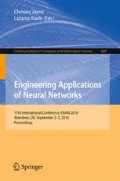Abstract
Electroencephalography (EEG) has recently emerged as a useful neurophysiological biomarker for characterizing different physiological and pathological conditions of healthy and un-healthy brain activity measurements. However, the complexity and high temporal resolution of the EEG signal data has brought about the need for efficient and accurate automated methods for distinguishing mental tasks activities and the recording conditions. Distinguishing mental tasks with high accuracy is pertinent for early detection and clinical diagnostic of several neurodegenerative diseases. Expert clinicians are needed in order to distinguish between mental tasks and EEG recording conditions, which is a manual process that is prone to inefficiencies and errors especially when the EEG data is miss-annotated at the recording stage. This paper proposes the application of a Self-organizing neural network Map (SOM) with Learning Vector Quantization (LVQ) for EEG Eyes Open (EO) and Eyes Closed (EC) condition classification. This was achieved with classification accuracy of 88.5 %. The proposed approach shows good performance and hence the method can be readily applied to other classification/clustering problems on brain measurements in the Brain Computer Interface (BCI) arena.
Access this chapter
Tax calculation will be finalised at checkout
Purchases are for personal use only
References
Mbuya, S.: The role of neuro-electrophysiological diagnostic tests in clinical medicine. East Afr. Med. J. 83, 52–60 (2006)
Al-Qazzaz, N.K., Ali, S.H., Ahmad, S.A., Chellappan, K., Islam, M.S., Escudero, J.: Role of EEG as biomarker in the early detection and classification of dementia. Sci. World J. 2014, 1–16 (2014). Article ID 906038
Liu, Y., Sourina, O., Nguyen, M.K.: Real-time EEG-based emotion recognition and its applications. In: Gavrilova, M.L., Tan, C., Sourin, A., Sourina, O. (eds.) Transactions on Computational Science XII. LNCS, vol. 6670, pp. 256–277. Springer, Heidelberg (2011)
Niedermeyer, E., da Silva, F.L.: Electroencephalography: Basic Principles, Clinical Applications, and Related Fields. Lippincott Williams & Wilkins, Philadelphia (2005)
Thuraisingham, R.A., Tran, Y., Craig, A., Nguyen, H.: Frequency analysis of eyes open and eyes closed EEG signals using the Hilbert-Huang Transform, pp. 2865–2868 (2012)
AKBEN SB Online EEG eye state detection in time domain by using local amplitude increase
Sakaia, M., Weia, D., Kongb, W., Daib, G., Hub, H.: Detection of change in alpha wave following eye closure based on KM2O-langevin equation. Int. J. Bioelectromag. 12, 89–93 (2010)
Schalk, G., McFarland, D.J., Hinterberger, T., Birbaumer, N., Wolpaw, J.R.: BCI2000: a general-purpose brain-computer interface (BCI) system. IEEE Trans. Biomed. Eng. 51, 1034–1043 (2004)
Huang, D., Qian, K., Fei, D., Jia, W., Chen, X., Bai, O.: Electroencephalography (EEG)-based brain–computer interface (BCI): a 2-D virtual wheelchair control based on event-related desynchronization/synchronization and state control. IEEE Trans. Neural Syst. Rehabil. Eng. 20, 379–388 (2012)
Sörnmo, L., Laguna, P.: Bioelectrical Signal Processing in Cardiac and Neurological Applications. Academic Press, London (2005)
Koessler, L., Maillard, L., Benhadid, A., Vignal, J.P., Felblinger, J., Vespignani, H., Braun, M.: Automated cortical projection of EEG sensors: anatomical correlation via the international 10–10 system. Neuroimage 46, 64–72 (2009)
Snyder, S.M., Hall, J.R., Cornwell, S.L., Falk, J.D.: Addition of EEG improves accuracy of a logistic model that uses neuropsychological and cardiovascular factors to identify dementia and MCI. Psychiatry Res. 186, 97–102 (2011)
Kohonen, T.: The self-organizing map. Proc. IEEE 78, 1464–1480 (1990)
Chakraborty, B., Menezes, A., Dandapath, S., Fernandes, W.A., Karisiddaiah, S., Haris, K., Gokul, G.: Application of hybrid techniques (self-organizing map and fuzzy algorithm) using backscatter data for segmentation and fine-scale roughness characterization of seepage-related seafloor along the western continental margin of India. IEEE J. Oceanic Eng. 40, 3–14 (2015)
Yu, H., Khan, F., Garaniya, V.: Risk-based fault detection using self-organizing map. Reliab. Eng. Syst. Saf. 139, 82–96 (2015)
Rigamonti, M., Baraldi, P., Zio, E., Alessi, A., Astigarraga, D., Galarza, A.: A self-organizing map-based monitoring system for insulated gate bipolar transistors operating in fully electric vehicle, vol. 6 (2015)
Merkevičius, E., Garšva, G., Simutis, R.: Forecasting of credit classes with the self-organizing maps 33 (2015)
Merényi, E., Mendenhall, M.J., O’Driscoll, P.: Advances in Self-Organizing Maps and Learning Vector Quantization. Advances in Intelligent Systems and Computing. Springer, Switzerland (2016)
Mans, R., Schonenberg, M., Song, M., van der Aalst, W., Bakker, P.: Process Mining in Healthcare (2015)
Hammer, B., Villmann, T.: Generalized relevance learning vector quantization. Neural Netw. 15, 1059–1068 (2002)
Murugappan, M., Murugappan, S.: Human emotion recognition through short time Electroencephalogram (EEG) signals using Fast Fourier Transform (FFT), pp. 289–294 (2013)
Goldberger, A.L., Amaral, L.A., Glass, L., Hausdorff, J.M., Ivanov, P.C., Mark, R.G., Mietus, J.E., Moody, G.B., Peng, C.K., Stanley, H.E.: PhysioBank, PhysioToolkit, and PhysioNet: components of a new research resource for complex physiologic signals. Circulation 101, E215–E220 (2000)
Author information
Authors and Affiliations
Corresponding author
Editor information
Editors and Affiliations
Rights and permissions
Copyright information
© 2016 Springer International Publishing Switzerland
About this paper
Cite this paper
Hamdoun, H., Usman, A.A. (2016). EEG-Based Condition Clustering using Self-Organising Neural Network Map. In: Jayne, C., Iliadis, L. (eds) Engineering Applications of Neural Networks. EANN 2016. Communications in Computer and Information Science, vol 629. Springer, Cham. https://doi.org/10.1007/978-3-319-44188-7_11
Download citation
DOI: https://doi.org/10.1007/978-3-319-44188-7_11
Published:
Publisher Name: Springer, Cham
Print ISBN: 978-3-319-44187-0
Online ISBN: 978-3-319-44188-7
eBook Packages: Computer ScienceComputer Science (R0)

